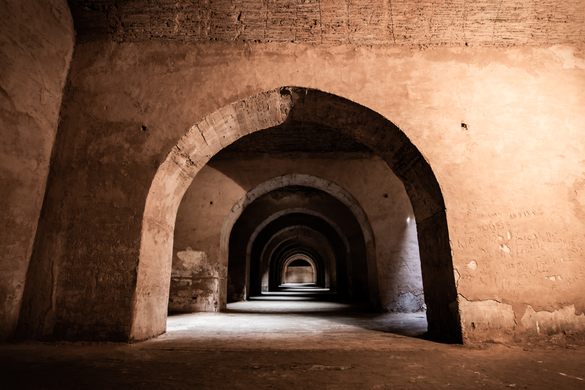Beneath the imperial city of Meknes, in the heart of Morocco, lies a haunting underground maze that whispers stories of cruelty, power, and mystery: the Kara Prison.Walled in silence and shrouded in shadows, this subterranean dungeon was more than just a place of imprisonment—it was a statement of absolute authority and an enigma that continues to baffle historians and stir the imagination of travelers to this day.
A Dungeon Beneath an Empire
Built during the reign of Sultan Moulay Ismaïl (1672–1727), Kara Prison is named after Kara, a Christian architect (possibly Portuguese or Spanish by origin) who designed the dungeon at the Sultan’s command. Moulay Ismaïl, often referred to as Morocco’s “Sun King,” was a powerful and fearsome ruler who sought to make Meknes a grand imperial capital—one to rival Versailles.
But while the Sultan erected palaces and gates of grandeur above ground, he also constructed something far more sinister below — a vast, cold prison, meant to disappear men from memory.
A Labyrinth Without End
The Kara Prison lies beneath the city and is said to stretch for miles beneath the royal kasbah and beyond. Only a small section is open to the public today, but even that gives an eerie sense of the larger, hidden whole.
The space is dimly lit, with arched stone ceilings, endless corridors, and thick suffocating walls. There are no windows, no natural light, and no air except the damp chill that seeps through stone.
Some believe the labyrinth connects to other secret locations in Meknes—perhaps even the royal palace or other underground chambers once used for covert purposes.
“When you enter, you feel the weight of forgotten lives. The silence speaks louder than any words.” – A local guide in Meknes
Who Were the Prisoners?
Kara Prison was said to hold up to 60,000 captives, primarily Christian slaves, captured during naval raids or battles against European powers.
Many were Portuguese, Spanish, and French prisoners forced into hard labor — constructing the walls, palaces, and stables of Meknes. They were the invisible workforce behind Moulay Ismaïl’s dream of a glorious capital.
The prison also reportedly held political prisoners, rebels, and anyone who dared challenge the Sultan’s authority.
Fates Sealed in Darkness
Meknes’ Enigmatic Labyrinth: The Kara Prison’s Subterranean Secrets Sealed in Darkness
For most prisoners, the Kara dungeon was a life sentence. There were no cells; prisoners were chained to pillars or left to roam the open stone chambers in constant darkness.
There was no official documentation of who went in or came out. Many starved, succumbed to disease, or lost their minds in the endless darkness.
Escape? There are no credible records of any prisoner escaping. The underground complex was so vast and disorienting that even if one managed to break free from chains, the labyrinth would swallow them whole.
Some legends speak of prisoners who died trying to find an exit, their ghosts still wandering the tunnels.
The ongoing preservation efforts aim to ensure that this cryptic labyrinth endures as a historical treasure. As we explore its dimly lit corridors and contemplate the lives that were once confined here, we are reminded of the power of the human spirit and the relentless quest for freedom.
In the heart of Meknes, the Kara Prison is a poignant reminder of a time when darkness enveloped those who dared to defy the Sultan’s rule. Its eerie silence now invites us to reflect on the mysteries of history, leaving us with more questions than answers, and the enduring legacy of Sultan Ismail bin Sharif’s reign in Morocco.
Thank you.
Fact or Folklore?
Much of what is known about Kara Prison blends history and legend. While Sultan Moulay Ismaïl did keep a large slave workforce, the exact capacity of the prison and its full reach remains a mystery.
Some scholars suggest the prison’s size and cruelty may be exaggerated through oral tradition, turning it into a symbol of tyranny and fear.
Yet the stone cold silence, the claustrophobic architecture, and the absence of light leave no doubt about the suffering that took place here.
Shadows Of The Past:
The Kara Prison remains one of Morocco’s most enigmatic historical sites…a haunting reminder of the human cost behind imperial ambition. Whether all the stories are true or mythologized over centuries, one thing is certain: the walls of this prison have witnessed a silence so deep it echoes through time.
In a city where splendor and cruelty coexisted above and below ground, Kara Prison is a chilling testament to the power of memory, legend, and the unseen side of history.
If you ever walk its corridors, tread lightly — for every stone beneath your feet may be a story left untold.
As you descend into the depths of Kara Prison, corridors like the one pictured above stretch endlessly ahead — haunting, cold, and eerily symmetrical. Designed to disorient and contain, these arched passages are the very bones of a cruel masterpiece. Whether part of the dungeon itself or the adjoining granaries, the space reflects the Sultan’s dual obsession: building an empire above ground, and burying resistance below it.


